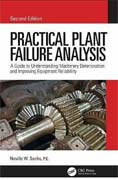Description
This is a practical guide for those who do the work of maintaining and improving the reliability of mechanical machinery. It is for engineers and skilled trades personnel who want to understand how failures happen and how the physical causes of the great majority can be readily diagnosed in the field.
It explains the four major failure mechanisms, wear, corrosion, overload, and fatigue and, using easy-to-read charts, how they can be diagnosed at the site of the failure. Then, knowing the physical failure mechanics involved, the reader can accurately solve the human causes.
To improve the reader’s understanding, all the diagrams and most of the tables have been redrawn. The number of actual failure examples has been increased, plus the last chapter on miscellaneous machine elements includes new material on couplings, universal joints, and plain bearings.
CRC Press
Published October 2019
382 Pages
380 Illustrations
Features
- A practical field guide showing how to recognize how failures occur that can be used to solve more than 85% of mechanical machinery failures
- Incorporates multiple easy-to-follow logic trees to help the reader diagnose the physical causes of the failure without needing detailed laboratory analysis
- Explains how the mechanics, corrosion, materials science, and tribology of components can fit together to improve machinery reliability
- Includes more than 150 completely redrawn charts and tables, plus almost 250 actual failure photographs to help guide the reader to an accurate analysis
- Contains clear and detailed explanations of how lubricants function and the critical roles of corrosion and lubrication play in causing mechanical failures
Table of Contents
1. An Introduction to Failure Analysis
2. Some General Considerations on Failure Analysis
3. Materials and the Sources of Stresses
4. Overload Failures
5. Fatigue Failures (Part 1): The Basics
6. Fatigue ( Part 2): Torsional, Low, and Very Low Cycle Failure Influences, and Some Fatigue Interpretations
7. Understanding and Recognizing Corrosion
8. Lubrication and Wear
9. Belt Drives
10. Ball and Roller Bearings
11. Gears
12. Fasteners and Bolted Joint Failures
13. Miscellaneous Machine Component Failures-Chains, Lip Seals, Couplings, Universal Joints, and Plain Bearings




